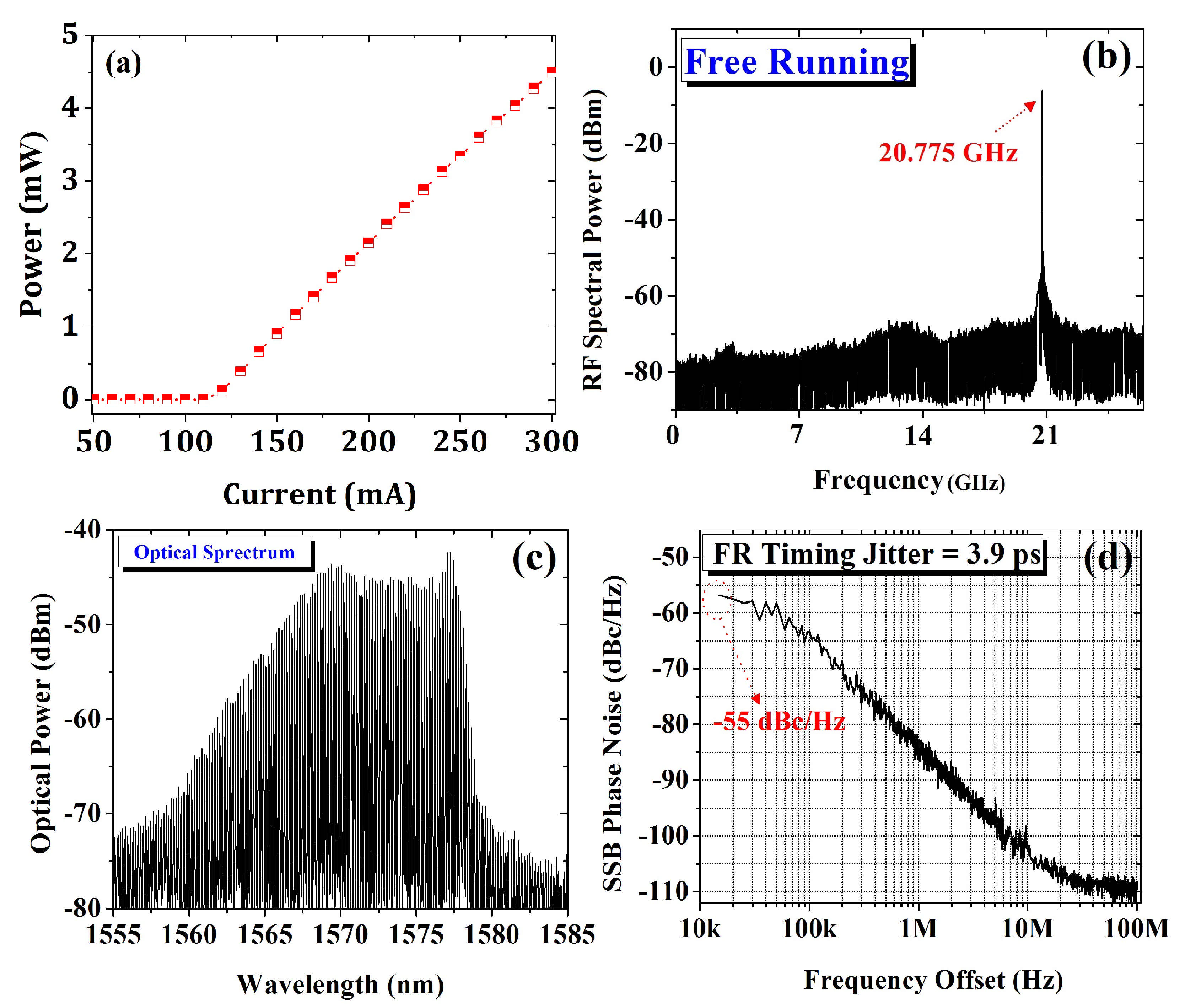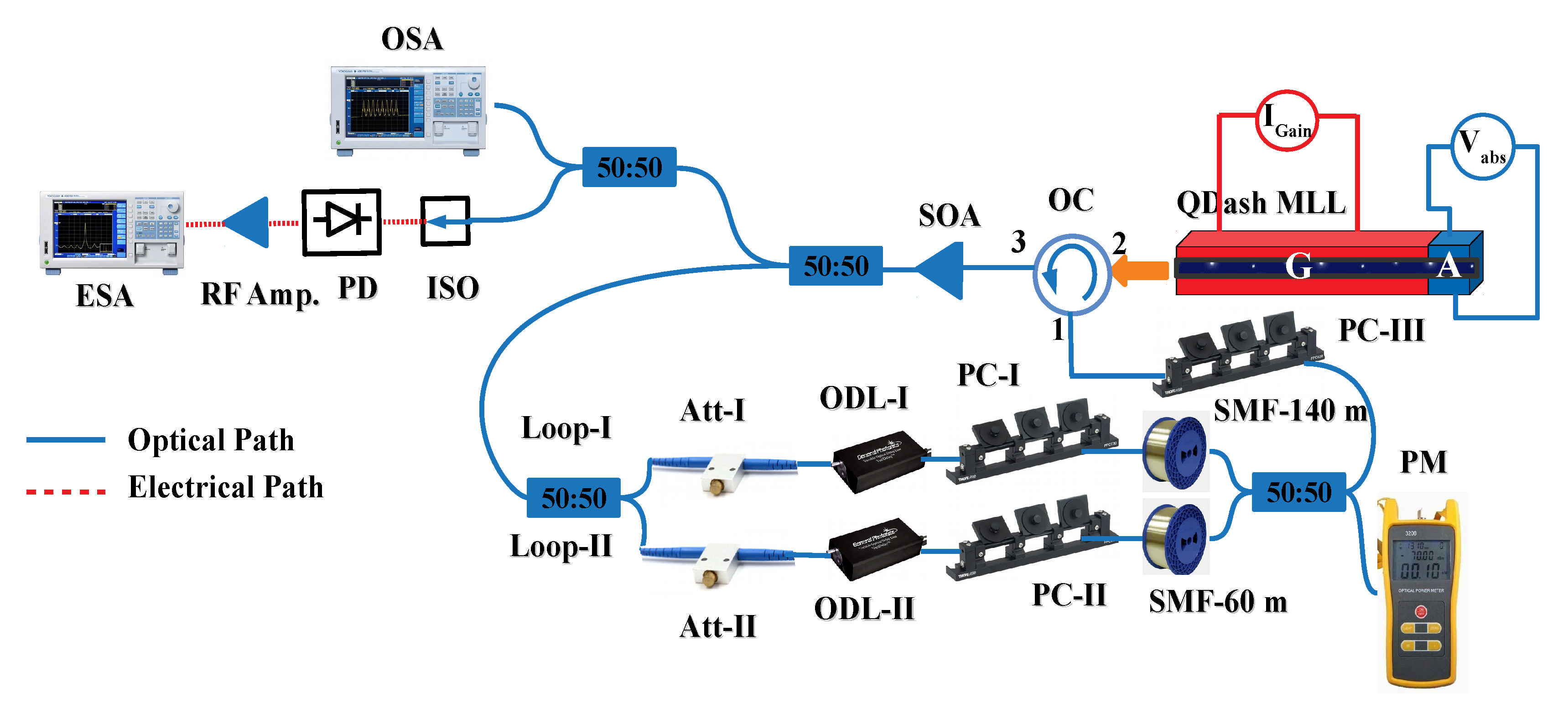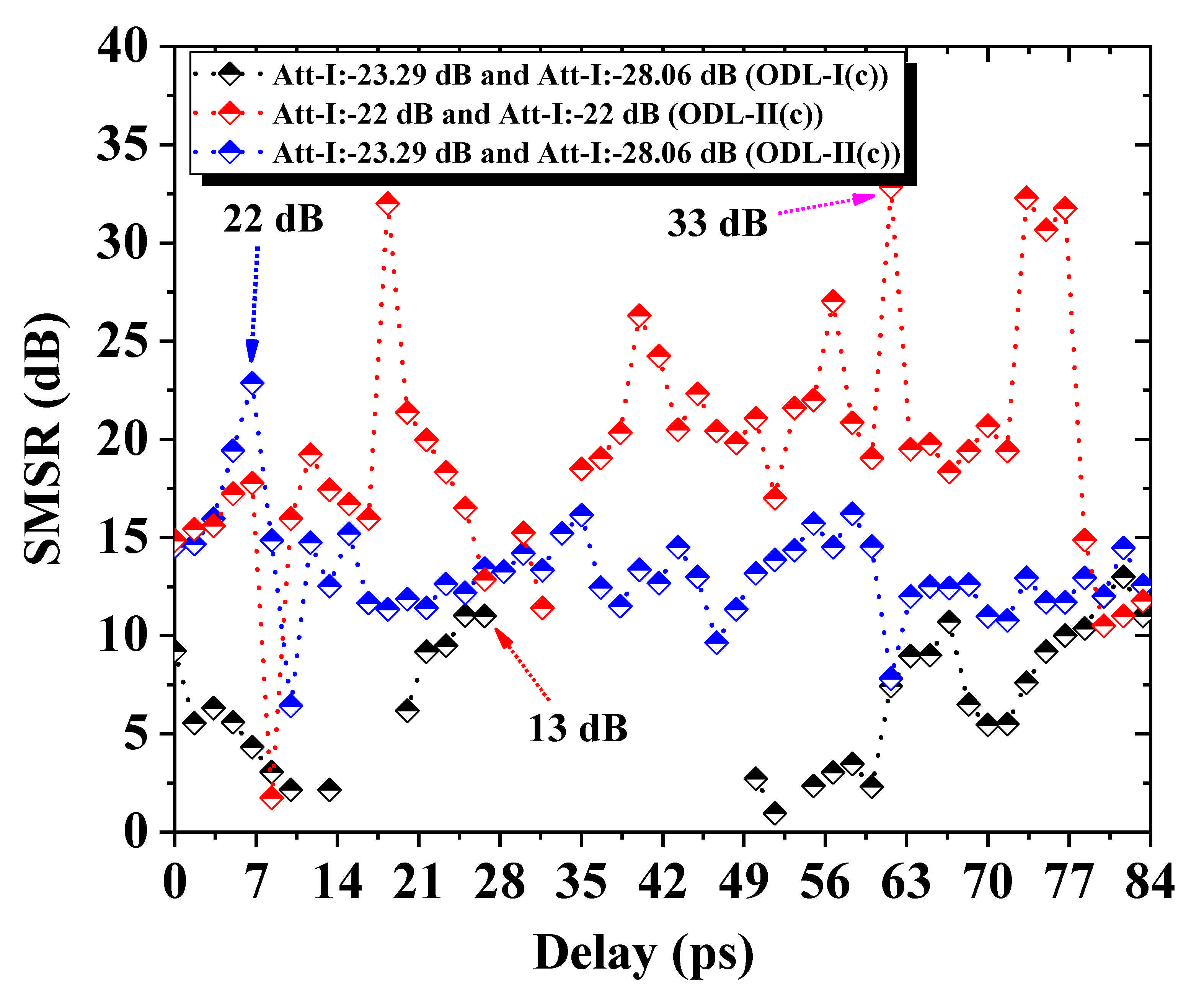Control of Timing Stability, and Suppression in Delayed Feedback Induced Frequency-Fluctuations by Means of Power Split Ratio and Delay Phase-Dependent Dual-Loop Optical Feedback
Abstract
:1. Introduction
2. Experimental Arrangements
3. Results and Discussion
3.1. Effect of Coupling Strengths and Delay Phase Settings on the Suppression of Cavity Induced Frequency-Fluctuations
3.1.1. Loop-I: ∼−23.29 dB and Loop-II: ∼−28.06 dB (Fine-Tuning of Stronger Cavity and Set Weaker Cavity to Fully Resonance)
3.1.2. Loop-I: ∼−23.29 dB and Loop-II: ∼−28.06 dB (Fine-Tuning of Weaker Cavity and Set Stronger Cavity to Fully Resonance)
3.1.3. Loop-I: ∼−22 dB and Loop-II: ∼−22 dB
4. Key Parameters Desired to Optimize External Cavity Induced Side-Bands
5. Conclusions
Author Contributions
Funding
Conflicts of Interest
References
- Devgan, P. A review of optoelectronic oscillators for high speed signal processing applications. ISRN Electron. 2013, 2013, 401969. [Google Scholar] [CrossRef]
- Jiang, F.; Lam, H.Q.; Zhou, J.; Zhang, H.; Shum, P.P.; Zhang, X. Application of coupled optoelectronic oscillator on optical sampling. Procedia Eng. 2016. [Google Scholar] [CrossRef] [Green Version]
- Devgan, P. Applications of optoelectronic oscillators for high speed clock recovery and RF signal discrimination. In Proceedings of the 2014 IEEE Photonics Conference, San Diego, CA, USA, 12–16 October 2014; pp. 410–411. [Google Scholar]
- Dai, J.; Xu, X.; Wu, Z.; Dai, Y.; Yin, F.; Zhou, Y.; Li, J.; Xu, K. Self-oscillating optical frequency comb generator based on an optoelectronic oscillator employing cascaded modulators. Opt. Express 2015, 23, 30014–30019. [Google Scholar] [CrossRef] [PubMed]
- Zhou, P.; Zhang, F.; Gao, B.; Pan, S. Optical pulse generation by an optoelectronic oscillator with optically injected semiconductor laser. IEEE Photonics Technol. Lett. 2016, 28, 1827–1830. [Google Scholar] [CrossRef]
- Yao, X.S.; Lutes, G.F.; Maleki, L.; Cao, X. Novel photonic clock and carrier recovery device. In Proceedings of the 27th Annual Precise Time and Time Interval Systems and Applications Meeting, San Diego, CA, USA, 29 November–1 December 1995; Volume 2556, pp. 118–128. [Google Scholar]
- Yao, X.S.; Lutes, G. A high-speed photonic clock and carrier recovery device. IEEE Photonics Technol. Lett. 1996, 8, 688–690. [Google Scholar] [CrossRef]
- Bánky, T.; Horváth, B.; Berceli, T. Optimum configuration of multiloop optoelectronic oscillators. JOSA B 2006, 23, 1371–1380. [Google Scholar] [CrossRef]
- Beato, V.; Sendina-Nadal, I.; Gerdes, I.; Engel, H. Noise-induced wave nucleations in an excitable chemical reaction. Phys. Rev. E 2005, 71, 035204. [Google Scholar] [CrossRef] [Green Version]
- Stegemann, G.; Balanov, A.G.; Schöll, E. Noise-induced pattern formation in a semiconductor nanostructure. Phys. Rev. E 2005, 71, 016221. [Google Scholar] [CrossRef]
- Hizanidis, J.; Balanov, A.; Amann, A.; Schöll, E. Noise-induced front motion: Signature of a global bifurcation. Phys. Rev. Lett. 2006, 96, 244104. [Google Scholar] [CrossRef] [Green Version]
- Giacomelli, G.; Giudici, M.; Balle, S.; Tredicce, J.R. Experimental evidence of coherence resonance in an optical system. Phys. Rev. Lett. 2000, 84, 3298. [Google Scholar] [CrossRef] [Green Version]
- Ushakov, O.V.; Wünsche, H.; Henneberger, F.; Khovanov, I.A.; Schimansky-Geier, L.; Zaks, M.A. Coherence resonance near a Hopf bifurcation. Phys. Rev. Lett. 2005, 95, 123903. [Google Scholar] [CrossRef] [Green Version]
- Shamim, M.H.M.; Shemis, M.A.; Shen, C.; Oubei, H.M.; Ng, T.K.; Ooi, B.S.; Khan, M.Z.M. Investigation of Self-Injection Locked Visible Laser Diodes for High Bit-Rate Visible Light Communication. IEEE Photonics J. 2018, 10, 7905611. [Google Scholar] [CrossRef]
- Khan, M.T.A.; Shemis, M.A.; Ragheb, A.M.; Esmail, M.A.; Fathallah, H.A.; Alshebeili, S.; Khan, M.Z.M. 4 m/100 Gb/s Optical Wireless Communication Based on Far L–Band Injection Locked Quantum-Dash Laser. IEEE Photonics J. 2017, 9, 7901807. [Google Scholar] [CrossRef]
- Kemal, J.N.; Marin-Palomo, P.; Panapakkam, V.; Trocha, P.; Wolf, S.; Merghem, K.; Lelarge, F.; Ramdane, A.; Randel, S.; Freude, W.; et al. Coherent WDM transmission using quantum-dash mode-locked laser diodes as multi-wavelength source and local oscillator. Opt. Express 2019, 27, 31164–31175. [Google Scholar] [CrossRef] [Green Version]
- Ellis, A.; Gunning, F. Spectral density enhancement using coherent WDM. IEEE Photonics Technol. Lett. 2005, 17, 504–506. [Google Scholar] [CrossRef]
- Yilmaz, T.; DePriest, C.; Turpin, T.; Abeles, J.; Delfyett, P. Toward a photonic arbitrary waveform generator using a mode-locked external cavity semiconductor laser. IEEE Photonics Technol. Lett. 2002, 14, 1608–1610. [Google Scholar] [CrossRef]
- Misas, J.; Petropoulos, P.; Richardson, D. All-optical signal processing of periodic signals using a brillouin gain comb. J. Lightw. Technol. 2008, 26, 3110–3117. [Google Scholar] [CrossRef] [Green Version]
- Liu, G.; Lu, Z.; Liu, J.; Mao, Y.; Vachon, M.; Song, C.; Barrios, P.; Poole, P.J. Passively mode-locked quantum dash laser with an aggregate 5.376 Tbit/s PAM-4 transmission capacity. Opt. Express 2020, 28, 4587–4593. [Google Scholar] [CrossRef]
- Fukushima, S.; Silva, C.; Muramoto, Y.; Seeds, A. Optoelectronic millimeter-wave synthesis using an optical frequency comb generator, optically injection locked lasers, and a unitraveling-carrier photodiode. J. Lightw. Technol. 2003, 21, 3043–3051. [Google Scholar] [CrossRef] [Green Version]
- Lang, R.; Kobayashi, K. External optical feedback effects on semiconductor injection laser properties. IEEE J. Quantum Electron. 1980, 16, 347–355. [Google Scholar] [CrossRef]
- Kobayashi, S.; Kimura, T. Injection locking in AlGaAs semiconductor laser. IEEE J. Quantum Electron. 1981, 17, 681–689. [Google Scholar] [CrossRef]
- Solgaard, O.; Lau, K.Y. Optical feedback stabilization of the intensity oscillations in ultrahigh-frequency passively modelocked monolithic quantum-well lasers. IEEE Photonics Technol. Lett. 1993, 5, 1264–1267. [Google Scholar] [CrossRef]
- Lin, C.-Y.; Grillot, F.; Li, Y.; Raghunathan, R.; Lester, L.F. Microwave characterization and stabilization of timing jitter in a quantum-dot passively mode-locked laser via external optical feedback. IEEE J. Sel. Top. Quantum Electron. 2011, 17, 1311–1317. [Google Scholar] [CrossRef]
- Arsenijević, D.; Kleinert, M.; Bimberg, D. Phase noise and jitter reduction by optical feedback on passively mode-locked quantum-dot lasers. Appl. Phys. Lett. 2013, 103, 231101. [Google Scholar] [CrossRef]
- Sooudi, E.; de Dios, C.; McInerney, J.G.; Huyet, G.; Lelarge, F.; Merghem, K.; Rosales, R.; Martinez, A.; Ramdane, A.; Hegarty, S.P. A novel scheme for two-level stabilization of semiconductor mode-locked lasers using simultaneous optical injection and optical feedback. IEEE J. Sel. Top. Quantum Electron. 2013, 19, 1101208. [Google Scholar] [CrossRef]
- Haji, M.; Hou, L.; Kelly, A.E.; Akbar, J.; Marsh, J.H.; Arnold, J.M.; Ironside, C.N. High frequency optoelectronic oscillators based on the optical feedback of semiconductor mode-locked laser diodes. Opt. Express 2012, 20, 3268–3274. [Google Scholar] [CrossRef]
- Jaurigue, L.; Nikiforov, O.; Schöll, E.; Breuer, S.; Lüdge, K. Dynamics of a passively mode-locked semiconductor laser subject to dual-cavity optical feedback. Phys. Rev. E 2016, 93, 022205. [Google Scholar] [CrossRef]
- Nikiforov, O.; Jaurigue, L.; Drzewietzki, L.; Lüdge, K.; Breuer, S. Experimental demonstration of change of dynamical properties of a passively mode-locked semiconductor laser subject to dual optical feedback by dual full delay-range tuning. Opt. Express 2016, 24, 14301–14310. [Google Scholar] [CrossRef]
- Asghar, H.; Sooudi, E.; McInerney, J.G. Stabilization of self-mode-locked QDash lasers subject to simultaneous continuous-wave optical injection and optical feedback. Appl. Opt. 2018, 57, E45–E49. [Google Scholar] [CrossRef]
- Asghar, H.; Wei, W.; Kumar, P.; Sooudi, E.; McInerney, J.G. Stabilization of self-mode-locked quantum dash lasers by symmetric dual-loop optical feedback. Opt. Express 2018, 26, 4581–4592. [Google Scholar] [CrossRef] [Green Version]
- Asghar, H.; Sooudi, E.; Kumar, P.; Wei, W.; McInerney, J.G. Optimum stabilization of self-mode-locked quantum dash lasers using dual optical feedback with improved tolerance against phase delay mismatch. Opt. Express 2017, 25, 15796–15805. [Google Scholar] [CrossRef] [PubMed]
- Asghar, H.; McInerney, J.G. Asymmetric dual-loop feedback to suppress spurious tones and reduce timing jitter in self-mode-locked quantum-dash lasers emitting at 1.55 μm. Opt. Lett. 2017, 42, 3714–3717. [Google Scholar] [CrossRef] [PubMed]
- Asghar, H.; Sooudi, E.; Baig, M.A.; McInerney, J.G. Recent advances in stabilization of mode-locked quantum dash lasers at 1.55 μm by dual-loop optical feedback. Opt. Laser Technol. 2020, 122, 105884. [Google Scholar] [CrossRef]
- Asghar, H.; McInerney, J.G. Effects of Power Split Ratio and Optical Delay Phase Tuning on Stabilization of Self-Mode-Locked Quantum-Dash Lasers Subject to Dual-Loop Optical Feedback. IEEE Photonics J. 2020, 12, 1–11. [Google Scholar] [CrossRef]
- Jaurigue, L.; Schöll, E.; Lüdge, K. Suppression of noise-induced modulations in multidelay systems. Phys. Rev. Lett. 2016, 117, 154101. [Google Scholar] [CrossRef]
- Cho, J.-H.; Kim, H.; Sung, H. Performance optimization of an optically combined dual-loop optoelectronic oscillator based on optical interference analysis. Opt. Eng. 2017, 56, 066111. [Google Scholar] [CrossRef]
- Lelarge, F.; Dagens, B.; Renaudier, J.; Brenot, R.; Accard, A.; van Dijk, F.; Make, D.; Le Gouezigou, O.; Provost, J.-Y.; Poingt, F.; et al. Recent Advances on InAs/InP Quantum Dash Based Semiconductor Lasers and Optical Amplifiers Operating at 1.55 μm. IEEE J. Sel. Top. Quantum Electron. 2007, 13, 111–124. [Google Scholar] [CrossRef]



| Coupling Strength | SMSR (i) | SMSR (0–84 ps) |
|---|---|---|
| −23.29 (c):−28.06 dB | 13 dB | >1–13 dB |
| −23.29:−28.06 (c) dB | 22 dB | >6–22 dB |
| −22:−22 dB | 33 dB | >13–33 dB |
Publisher’s Note: MDPI stays neutral with regard to jurisdictional claims in published maps and institutional affiliations. |
© 2021 by the authors. Licensee MDPI, Basel, Switzerland. This article is an open access article distributed under the terms and conditions of the Creative Commons Attribution (CC BY) license (https://creativecommons.org/licenses/by/4.0/).
Share and Cite
Asghar, H.; McInerney, J.G. Control of Timing Stability, and Suppression in Delayed Feedback Induced Frequency-Fluctuations by Means of Power Split Ratio and Delay Phase-Dependent Dual-Loop Optical Feedback. Appl. Sci. 2021, 11, 4529. https://doi.org/10.3390/app11104529
Asghar H, McInerney JG. Control of Timing Stability, and Suppression in Delayed Feedback Induced Frequency-Fluctuations by Means of Power Split Ratio and Delay Phase-Dependent Dual-Loop Optical Feedback. Applied Sciences. 2021; 11(10):4529. https://doi.org/10.3390/app11104529
Chicago/Turabian StyleAsghar, Haroon, and John G. McInerney. 2021. "Control of Timing Stability, and Suppression in Delayed Feedback Induced Frequency-Fluctuations by Means of Power Split Ratio and Delay Phase-Dependent Dual-Loop Optical Feedback" Applied Sciences 11, no. 10: 4529. https://doi.org/10.3390/app11104529






